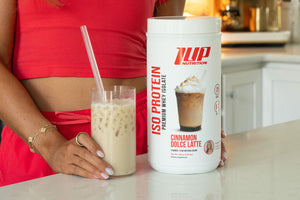The GI tract plays a critical role in your health, wellness, and resistance to illness and infection since it is responsible for digesting food, absorbing nutrients, and eliminating toxins and waste from the body.
Unfortunately, many people suffer from various GI ailments including cramping, bloating, gas, diarrhea, and constipation.
There are a number of causes for why an individual can experience GI distress, but one of the primary contributors is diet.
What you eat (or don’t eat) can have a profound impact on the makeup and function of your gut.
Today, we give you a rundown of our 10 best foods to improve digestion and support good gut health.
Top 10 Best Foods for Good Gut Health
Papaya
Papaya is a popular tropical fruit that is rife with nutrients that support health. Of particular interest are the enzymes papain and chymopapain, which help digest (break down) proteins.[1]
Research has shown that papain may also reduce symptoms of irritable bowel syndrome (IBS), such as constipation and bloating.[2]
Papaya also contains fiber which is always a bonus when supporting a healthy digestive tract.
Peppermint
Peppermint is a popular herb that has a long history of use for easing an upset stomach or feelings of indigestion. The reason for this is that peppermint helps slow down the stomach muscles and possible spasms that can lead to nausea.[3,4]
Research also finds that the menthol present in peppermint may help reduce stomach discomfort and bloating associated with IBS.[5]
Kimchi
Kimchi is a type of fermented cabbage rich in vitamins, minerals, and probiotics, which encourages the growth of good bacteria in your colon.
Studies also find that kimchi contains assorted compounds that stimulate immune function and combat free radicals and oxidative stress.[6]
Kimchi also contains fiber, which supports gut health and can add bulk to stool.
Kimchi is commonly eaten as a side dish along Korean food, but it’s not uncommon to see the fermented vegetable used in tacos, burgers, salads, or soup!
Ginger
Ginger is another age old culinary ingredient used to help reduce nausea and settle an uneasy stomach.[7]
Studies show that ginger helps accelerate gastric emptying[8] which helps reduce the risk of heartburn, nausea, and stomach discomfort.
Fresh ginger can be steeped in hot water to make a tummy-soothing tea, and dried ginger can be added to marinades, baked goods, and smoothies.
Yogurt
Yogurt is a fermented dairy product containing live, active cultures, which act as probiotics.[9]
Increasing the concentrations of good gut bacteria like Lactobacillus may improve lactose digestion and reduce symptoms of lactose intolerance.[9]
Be aware though, that not all yogurts at the grocery store are the same. Many contain lots of added sugar and fillers along with little to no probiotics. When shopping for your next container of yogurt, make sure the tub you purchase states “live and active cultures” on the package.
Kefir
Kefir is yogurt’s tangier cousin made by adding kefir “grains” (beneficial yeast and lactic acid bacteria) to milk.
Similar to the probiotics found in yogurt, kefir’s probiotics enhance lactose digestion and reduce some of the symptoms associated with lactose intolerance such as bloating, gas, and cramping.[10]
Additional research indicates that kefir consumption can increase the number of healthy, gut bacteria while reducing the number of harmful bacteria.[11]
Kefir consumption may also help decrease inflammation in the gut, further boosting GI function.
Almonds
Almonds and other nuts, such as pistachios, have been shown to increase Bifidobacteria in humans.[12]
In case you weren’t aware, Bifidobacteria are a type of “good” gut that have been noted to help combat intestinal inflammation and promote gut health.[13]
Nuts like almonds also contain lots of vitamins, minerals, and fiber which support gut health and proper digestion.
Kombucha
Kombucha is a type of fermented tea that has been consumed for centuries.
It is made by adding certain strains of bacteria and to black or green tea, then left to ferment for at least a week.
This fermentation process injects the tea with a plethora of probiotics which support gut health.
Kombucha has also received increasing interest for its anti-inflammatory and antioxidant potential.[14]
Chia Seeds
Chia seeds are the edible seeds of Salvia hispanica, a relative of mint family. When consumed, they form a gel-like substance in your stomach, which improves gastric motility and regularity.
Chia seeds are also an excellent source of fiber which help feed the good bacteria in your gut, thereby supporting good gut health.e growth of healthy bacteria in your gut and therein contributing to healthy digestion.[15]
Bone Broth
Bone broth has made a tremendous comeback in recent years thanks in large part to the growth of the keto and paleo diets as well as the heightened focus on gut health.
It’s made by cooking the bones and connective tissues of animals in simmering water. Adding a splash of vinegar also helps to release nutrients from the marrow.
One benefit of using the bones in the mixture is that it helps form gelatin, a type of protein rich in glutamine and glycine.
Glycine in particular has been noted for its role in promoting gut health, immune function, sleep, and cognitive function.[16]
Glutamine is also known to support the functioning of the intestinal wall, improve leaky gut, other inflammatory bowel diseases.[17]
1 UP Products that can help you with healthy digestion Gut Health Plus and Organic Greens and Reds Superfoods
References
- Stremnitzer C, Manzano-Szalai K, Willensdorfer A, et al. Papain Degrades Tight Junction Proteins of Human Keratinocytes In Vitro and Sensitizes C57BL/6 Mice via the Skin Independent of its Enzymatic Activity or TLR4 Activation. J Invest Dermatol. 2015;135(7):1790–1800. doi:10.1038/jid.2015.58
- Muss, C., Mosgoeller, W., & Endler, T. (2013). Papaya preparation (Caricol(R)) in digestive disorders. Neuro Endocrinology Letters, 34(1), 38–46.
- Khanna R, MacDonald JK, Levesque BG. Peppermint oil for the treatment of irritable bowel syndrome: a systematic review and meta-analysis. Journal of Clinical Gastroenterology. 2014 Jul;48(6):505-512. DOI: 10.1097/mcg.0b013e3182a88357.
- Inamori, M., Akiyama, T., Akimoto, K., Fujita, K., Takahashi, H., Yoneda, M., … Nakajima, A. (2007). Early effects of peppermint oil on gastric emptying: a crossover study using a continuous real-time 13C breath test (BreathID system). Journal of Gastroenterology, 42(7), 539–542. https://doi.org/10.1007/s00535-007-2067-3
- Cash BD, Epstein MS, Shah SM. A Novel Delivery System of Peppermint Oil Is an Effective Therapy for Irritable Bowel Syndrome Symptoms. Dig Dis Sci. 2016;61(2):560–571. doi:10.1007/s10620-015-3858-7
- Kim MS, Yang HJ, Kim SH, Lee HW, Lee MS. Effects of Kimchi on human health: A protocol of systematic review of controlled clinical trials. Medicine (Baltimore). 2018;97(13):e0163. doi:10.1097/MD.0000000000010163
- Viljoen E, Visser J, Koen N, Musekiwa A. A systematic review and meta-analysis of the effect and safety of ginger in the treatment of pregnancy-associated nausea and vomiting. Nutr J. 2014;13:20. Published 2014 Mar 19. doi:10.1186/1475-2891-13-20
- Wu, K.-L., Rayner, C. K., Chuah, S.-K., Changchien, C.-S., Lu, S.-N., Chiu, Y.-C., … Lee, C.-M. (2008). Effects of ginger on gastric emptying and motility in healthy humans. European Journal of Gastroenterology & Hepatology, 20(5), 436–440. https://doi.org/10.1097/MEG.0b013e3282f4b224
- Guarner, F., Perdigon, G., Corthier, G., Salminen, S., Koletzko, B., & Morelli, L. (2005). Should yoghurt cultures be considered probiotic? The British Journal of Nutrition, 93(6), 783–786.https://doi.org/10.1079/bjn20051428
- Hertzler, S. R., & Clancy, S. M. (2003). Kefir improves lactose digestion and tolerance in adults with lactose maldigestion. Journal of the American Dietetic Association, 103(5), 582–587.https://doi.org/10.1053/jada.2003.50111
- de Oliveira Leite AM, Miguel MA, Peixoto RS, Rosado AS, Silva JT, Paschoalin VM. Microbiological, technological and therapeutic properties of kefir: a natural probiotic beverage. Braz J Microbiol. 2013;44(2):341–349. Published 2013 Oct 30. doi:10.1590/S1517-83822013000200001
- Ukhanova, M., Wang, X., Baer, D. J., Novotny, J. A., Fredborg, M., & Mai, V. (2014). Effects of almond and pistachio consumption on gut microbiota composition in a randomised cross-over human feeding study. The British Journal of Nutrition, 111(12), 2146–2152. https://doi.org/10.1017/S0007114514000385
- Furrie E, Macfarlane S, Kennedy A, et al. Synbiotic therapy (Bifidobacterium longum/Synergy 1) initiates resolution of inflammation in patients with active ulcerative colitis: a randomised controlled pilot trial. Gut. 2005;54(2):242–249. doi:10.1136/gut.2004.044834
- Villarreal-Soto, S. A., Beaufort, S., Bouajila, J., Souchard, J.-P., & Taillandier, P. (2018). Understanding Kombucha Tea Fermentation: A Review. Journal of Food Science, 83(3), 580–588.https://doi.org/10.1111/1750-3841.14068
- Holscher HD. Dietary fiber and prebiotics and the gastrointestinal microbiota. Gut Microbes. 2017;8(2):172–184. doi:10.1080/19490976.2017.1290756
- Razak, M. A., Begum, P. S., Viswanath, B., & Rajagopal, S. (2017). Multifarious Beneficial Effect of Nonessential Amino Acid, Glycine: A Review. Oxidative Medicine and Cellular Longevity, 2017, 1716701. https://doi.org/10.1155/2017/1716701
- Wang, B., Wu, G., Zhou, Z., Dai, Z., Sun, Y., Ji, Y., Wu, Z. (2015). Glutamine and intestinal barrier function. Amino Acids, 47(10), 2143–2154. https://doi.org/10.1007/s00726-014-1773-4






